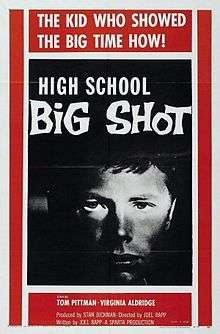High School Big Shot
| High School Big Shot | |
|---|---|
 One-sheet for "High School Big Shot" | |
| Directed by | Joel Rapp |
| Written by | Joel Rapp |
| Starring |
Tom Pittman Virginia Aldridge Howard Veit Malcolm Atterbury |
| Distributed by |
Sparta Productions Filmgroup |
Running time | 70 minutes |
| Country | United States |
| Language | English |
High School Big Shot is a 1959 film starring Tom Pittman as Marv Grant, a smart high school student whose plans for getting a college scholarship are threatened by his alcoholic father played by Malcolm Atterbury, and his relationship with the most popular girl in school. The plot is remarkably similar to that of Stanley Kubrick's The Killing, released only three years previous. High School Big Shot was featured on an episode of the popular comedy series Mystery Science Theater 3000. Filmed in 1958 under the title Blood Money, executive producer Roger Corman released the film as a double feature with T-Bird Gang in his first Filmgroup release.[1]
Plot
Marv Grant is a high school student who lives with his deadbeat, alcoholic father. At school he begins dating the attractive Betty Alexander (Virginia Aldridge), who eventually manipulates him into writing her English class term paper for her. Marv does this, but the subterfuge is easily uncovered by the professor. Betty fails the class, and the professor withdraws his recommendation from Marv's college application, without which Marv has no chance of earning a scholarship. In anger, Betty throws Marv over and returns to her old boyfriend, Vince, revealing that she had only been using Marv from the beginning.
At his part-time job at the docks, Marv overhears his boss plotting a drug transaction worth $1 million cash. The money will be kept in the office safe prior to the deal. In despair, Marv plots to steal the money, with the help of safecracker Harry March and another accomplice, to cure troubles with his father and Betty and he secures $550,000 of the take for himself. He tells Betty about the pending robbery to entice her to marry him, and she apparently accedes. In reality she secretively tasks her boyfriend, Vince, to steal the money from Marv.
Marv and his associates steal the money, but things then go horribly wrong when it's discovered Marv's father has hanged himself, then Vince and two accomplices intervene and shoots one of Marv's unarmed associates, and he is horrified. When Betty arrives on the scene soon afterwards, Vince accuses her of making him do this, and he kills her, too. Vince's accomplices flee, but the police soon arrive. Marv is arrested and the money falls into the water, being lost.
Similarities to The Killing
The plot may have been adapted from that of The Killing. In that film, George Peatty (Elisha Cook Jr.) is a window teller at a racetrack. He has a shrewish wife, Sherry (Marie Windsor), who is bitter that he has not delivered on the promises of wealth he made at the time of their marriage. She is also cheating on him.
A veteran criminal approaches George about being the inside man on a $2 million heist at the racetrack. Hoping to please his wife, George agrees, and he also tells her about the robbery. Sherry does not believe him at first, but, once she learns that the robbery is real, she recruits her lover, Val Cannon (Vince Edwards), to steal the money from her husband.
The robbery succeeds, but George and his accomplices are held up by Val and his men. A shootout ensues in which all but George are killed. George goes home to confront his wife, and kills her before dying himself. The last man left with the loot attempts to flee by plane, but the suitcase full of money breaks open on the tarmac and the contents are scattered to the winds.
Production
The film was financed by Roger Corman who was particularly impressed by the performance of Tom Pittman in the lead.[2]
Mystery Science Theater 3000
The film was featured in a sixth-season episode of Mystery Science Theater 3000. Main topics of ridicule for the writers were Marv's wimpy demeanor, huge lips and awkward appearance, his father's pathetic alcoholism, and the overall bleak nature of the film. The ending in particular prompted the writers to dub it "one of the most depressing films we've ever seen" and include a skit where the characters of the show "kill" each other with water guns to mock the fact that most of the major characters were killed in a brief moment of time, nearly one after the other.
See also
References
External links
- High School Big Shot at the Internet Movie Database
- High School Big Shot is available for free download at the Internet Archive